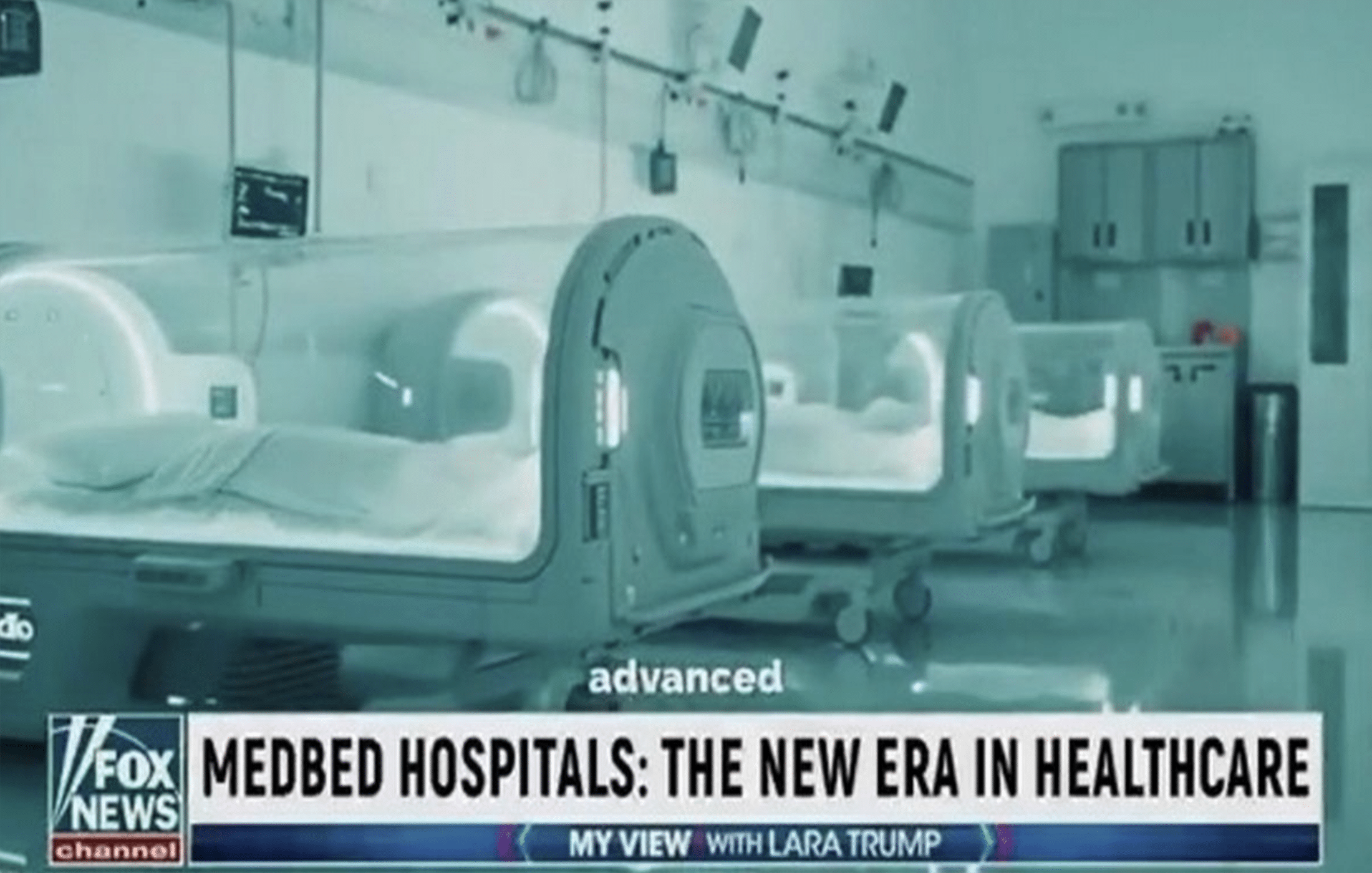Quantum MedBeds and Death Threats

Table of Contents
I never write about current politics. Or jump on the news of the day to insert myself into the discussion. This might be my first politics-adjacent post on this blog. In fact, for the sake of my own sanity, I’ve made a point of steering this blog and most of my day clear of politics and the daily chaos of partisan news. I prefer to focus on science and quantum tech.
However, recent events have dragged me out of that apolitical cocoon. Why? Because, I just received a death threat over something called “quantum medbeds.” It appears that by running a company with “Quantum” in the name, and by politely ignoring some very strange inquiries about providing medbed technology, I’ve been deemed part of a grand conspiracy to withhold miraculous healing devices from humanity. Apparently, in one person’s mind, I am at the core of keeping “life-saving technology” away from the people.
So let’s talk about medbeds.
What Are “MedBeds” Supposed to Be?
If you’re blissfully unaware of the medbed craze, here’s the quick rundown: In certain online circles (notably QAnon and other fringe groups), medbeds are believed to be miraculous medical devices – high-tech beds – that can heal any ailment. We’re talking about curing all diseases, regrowing missing limbs, even reversing aging. Basically, imagine every futuristic healing gadget from science fiction, rolled into one.
According to the conspiracy lore, these devices exist right now in secret. Believers claim medbeds are hidden in military facilities or bunkers, based on technology gleaned from classified government projects or even aliens, and that the deep state or big pharma is suppressing them. Some versions of the myth even rope in John F. Kennedy or other famous figures (e.g. “JFK is actually alive, being kept young on a medbed”) for extra flair.
It would be an understatement to call these claims far-fetched. Fantasy writers would find this “heal-anything bed” concept a bit too fantastical. Yet, medbed conspiracy theories have exploded in popularity on Telegram channels, TikTok videos, and Facebook groups that blend New Age wellness jargon with political paranoia. To give you an idea of how all-powerful medbeds are supposed to be, here are just a few abilities believers attribute to them:
- Cure every disease: From cancer to Lyme to the common cold – you name it, the medbed fixes it.
- Regrow limbs and organs: Lost an arm? Bad kidney? Hop on the bed and watch it regenerate in minutes.
- Reverse aging: Turn a 80-year-old into a 30-year-old. Essentially, medbeds promise biological immortality.
- Heal all injuries: Wounds, scars, even chronic pain – gone, as if they never happened.
If this sounds like science fiction, that’s because it is. But the allure of a single cure-all technology is so strong that many people have bought into the dream. In these circles, medbeds are a looming miracle – always “coming soon” but somehow never actually arriving. And in the meantime, the myth is fueled by a steady stream of misinformation and scams, which we’ll get to in a moment.
When a Sci-Fi Conspiracy Goes Mainstream
Until recently, “medbeds” were largely confined to fringe communities online. That changed a few days ago, when the conspiracy theory got an unwitting (or perhaps not-so-unwitting) signal boost from none other than Donald Trump.
Over the weekend, Trump’s Truth Social account shared a video that can only be described as bizarre. It was formatted to look like a Fox News breaking news segment featuring his daughter-in-law Lara Trump, and it announced the launch of America’s first MedBed hospital along with a national MedBed card system. In the clip, an AI-generated voice and video of Trump himself (sitting in the Oval Office) promised that “every American will soon receive their own MedBed card” granting access to new medbed-equipped healing centers. To be clear: all of this was fake. Fox News confirmed that no such segment ever aired on their network, and the video itself appears to have been entirely AI-generated, essentially a sophisticated deepfake. (One giveaway? The unusually steady and scripted delivery from Trump’s avatar – a level of message discipline the real man isn’t exactly known for, as some wags have noted with irony.)
Trump (or whoever manages his account) deleted the video the next morning, but the damage was done. In the ~12 hours it was up, it was viewed by millions. The result was a mix of confusion and excitement in conspiracy circles. Many of Trump’s followers realized the clip was AI-generated – and yet some still took it as confirmation that medbeds are real and that Trump was heralding their imminent rollout. In other words, even after the video was exposed as a fake, plenty of people responded with “See, I knew it! MedBeds are coming!” The medbed myth, once confined to niche Telegram groups, had just been amplified by the President of the United States. This is the point where a laughable sci-fi fantasy tips into a potentially dangerous mass delusion.
Quantum Buzzwords and Pseudoscience Soup
As someone working in quantum tech, one aspect of the medbed lore that really irks me is the gratuitous use of “quantum” as a buzzword. While not in the Trump-shared video itself, it is common online. Medbed promoters throw every science-y term at the wall to make these devices sound cutting-edge. According to various medbed “explainers” circulating online, these devices use some combination of ions, terahertz waves, frequencies, resonances, artificial intelligence, quantum technology, and even tachyons (why not throw in a faster-than-light particle for good measure?) It’s basically a word salad of whatever sounds futuristic. It’s beginning to sound like an out-of-breath child who just watched their first episode of Star Trek, as one science communicator quipped. In reality, none of these buzzwords translate into actual medical miracles. You can’t heal a severed spine with “frequencies” or reverse aging with “quantum energy” – those notions conflict with everything we know about biology and physics.
To be sure, the idea of a high-tech healing bed does come from science fiction. (The term “medbed” even shows up in sci-fi literature referring to advanced medical pods.) But conspiracy influencers have dressed up the fiction with just enough technobabble to convince people it could be real. In a guide to quantum hype and scams I published earlier this year, I even included “quantum med-beds” as a prime example of quantum woo – pseudoscience that abuses the word “quantum”. Believers claim secret quantum medbeds exist (courtesy of government or aliens) and use a mix of “quantum energy,” “tachyons,” “plasma,” and other exotic stuff to regenerate organs or roll back your biological clock. Needless to say, this is pure fiction.
MedBeds represent the extreme end of the misinformation spectrum: a claim so fantastical and untethered to reality that it really only thrives among those already primed to distrust mainstream science and medicine.
When Conspiracy Theory Gets Personal
It’s easy to laugh at the absurdity of all this – until it comes knocking on your door. My own brush with medbed mania went from mildly amusing to disturbingly personal. As I mentioned up top, I run a company called “Applied Quantum.”
In the past few months, our general contact email has received sporadic messages asking about medbed technology. At first, I ignored them; they seemed like random cranks or people who had us confused with a medical device supplier. But in the conspiracy world, a lack of response is often interpreted in the most paranoid way possible. In one case, a correspondent’s messages went from curious (“Do you guys provide quantum medbeds?”) to insistent (“Why are you not replying? We need this technology urgently.”) to unhinged. The final email I received from this person was essentially a death threat. It accused me and my company of deliberately withholding medbeds from the public, and warned that I would “pay the price” for my role in this imagined global cover-up.
I have to admit, reading that message was surreality at its finest. Here I am, someone who’s devoted to real advancements in science and tech, now cast as a villain in a ridiculous conspiracy narrative. A part of me wanted to respond with pure snark: “Dear Sir, I regret to inform you that our secret underground medbed lab is fresh out of alien healing pods. Please check back after the next lunar eclipse.” But this is no joking matter. It really drove home how dangerous and delusion-fueled some of these beliefs have become. When a person is so convinced that medbeds are real and being kept from them that they’re ready to threaten violence, something has gone badly wrong in our information ecosystem.
The Real Dangers: Scams and Health Risks
The personal threat I received is one symptom of a larger problem. Medbed misinformation doesn’t just prey on people’s hopes – it also opens them up to outright fraud and health dangers. Wherever a false hope takes root, scammers rush in to make a quick buck.

Unsurprisingly, an entire cottage industry has sprung up around medbeds. There are Facebook groups (many of them! see the image) and websites claiming to offer access to genuine medbeds (which, again, do not exist). The catch? You have to pay a “registration fee” to get on the waiting list. One investigation found a supposed medbed coordinator charging a $300 fee just to register for a future appointment at a medbed center. Another group advertised different country-specific contacts and was asking $500 upfront from hopeful patients. People are literally paying hundreds of dollars to reserve a spot in line for a fictional miracle. It’s the definition of cruel scam artistry: promise the desperate and sick a cure-all, take their money, and give nothing in return.
Other grifters have tried selling what we might call “bootleg” medbeds – devices that use the name but are just pseudoscientific junk. One company, for example, marketed a “Tesla MedBed Generator” (no relation to the car company) consisting of a special bed frame with some electronic canisters underneath it, claiming it could emanate “life force energy” to heal you. The U.S. FDA actually stepped in with a warning letter in 2023, because this outfit was making unapproved medical claims about its device. To be clear: no medbed device has any legitimate regulatory approval, because no real medbed has ever been demonstrated to work. The ones you see in slick online ads are either CGI renderings or repurposed health spa equipment bathed in blue LED lights to look high-tech. It’s all smoke and mirrors.
Perhaps the most tragic risk here is that vulnerable people might delay or forgo real medical treatment because they’re hanging their hopes on a medbed. Journalists and experts have noted that these conspiracy-fueled promises of a coming cure-all have led some believers to put off seeing doctors or stop their medications, expecting that any day now the medbeds will arrive and fix everything. Imagine someone with cancer foregoing chemo because they think an Army base is about to open a miraculous healing pod center – that’s not just sad, it’s life-threatening.
As McGill University’s Office for Science and Society put it, the medbed phenomenon is like a constantly dangled promise of imminent salvation, always shifting timelines and using fancy jargon to keep people hooked. It’s the medical equivalent of a doomsday cult that keeps revising the apocalypse date.
And now, with the AI-driven fake video that Trump shared, the medbed myth has been supercharged. A slickly produced deepfake gave a visual form to the conspiracy and lent it a veneer of legitimacy (at least for those who missed the clues that it was bogus).
Back in 2019, I wrote about the coming dangers of AI-generated “deepfake” disinformation, warning how such technology could erode our trust in what we see and hear. Even so, I never imagined we’d see the U.S. President accidentally (or deliberately) boosting a fringe sci-fi conspiracy with a deepfake news clip. It’s a case study in how misinformation and technology can create a perfect storm. If we aren’t careful, this won’t be the last time something like this happens.
Conclusion
It might be comforting to believe that a magical cure-all machine exists just around the corner, especially in a world full of real medical challenges. But reality doesn’t bend to our wishes. The quantum medbed conspiracy is pure lunacy – a stew of sci-fi tropes, pseudoscience, and snake-oil salesmanship. No matter how many fake videos or Facebook groups promote it, wishing something true doesn’t make it true.
As someone deeply involved in quantum technology, I hate seeing the word “quantum” hijacked to lend credibility to quackery. Quantum computing will be able to do amazing things, but it’s not going to heal your Grandma’s arthritis or regrow a lost limb. Those are challenges for real medical science, and progress there comes from hard research, not internet lore.
I urge my readers to help spread this message: don’t fall for the quantum medbed hoax, and don’t let your loved ones fall for it either. If you encounter someone sharing “news” about miracle medbeds, politely point them to the mountain of evidence debunking it. Encourage healthy skepticism: if a technology claims to do everything, ask for proof. Check if any reputable scientist or medical body backs these claims (spoiler: they don’t). Remember that extraordinary claims require extraordinary evidence – and an AI-fabricated video on social media is anything but good evidence.
Personally, this whole saga has been a wake-up call. Ignoring conspiracy theories might keep me sane for a while, but it doesn’t make them go away. Lies spread, and eventually they can cause real harm – whether it’s financial ruin, untreated illnesses, or threats to people’s safety. So consider this post my small act of pushing back.
Quantum Upside & Quantum Risk - Handled
My company - Applied Quantum - helps governments, enterprises, and investors prepare for both the upside and the risk of quantum technologies. We deliver concise board and investor briefings; demystify quantum computing, sensing, and communications; craft national and corporate strategies to capture advantage; and turn plans into delivery. We help you mitigate the cquantum risk by executing crypto‑inventory, crypto‑agility implementation, PQC migration, and broader defenses against the quantum threat. We run vendor due diligence, proof‑of‑value pilots, standards and policy alignment, workforce training, and procurement support, then oversee implementation across your organization. Contact me if you want help.



